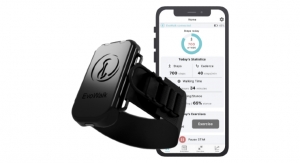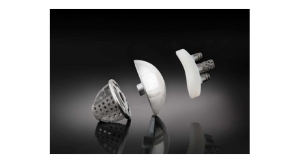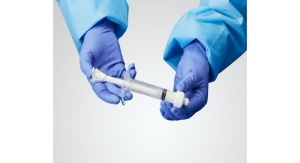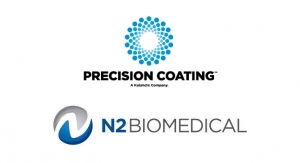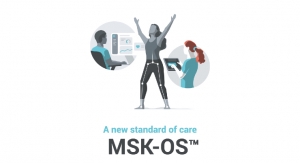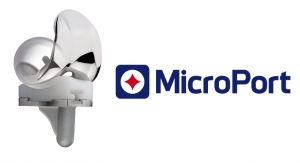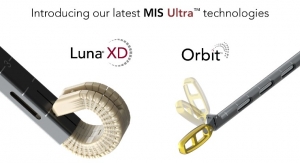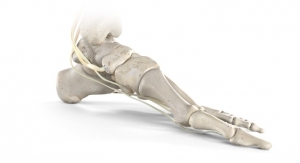Michael Barbella, Managing Editor04.01.15
Pity not the science-fiction protagonist, for he (or she) leads quite the coveted life. With an arsenal of mind-boggling technology at his disposal, the sci-fi hero’s world is a harmless, watered-down microcosm of manageable events—sans challenge, chaos and complication.
There are fixes for every conceivable threat to the human condition, from cancer, inebriation and insomnia to hunger, aging, even death. Ego-boosters such as physiognomic face-changing templates, designer eyes, false memory implants, and alternate realities are available as well.
Yet none of the elixirs are a match for the shape- shifting machine assassin featured in Philip K. Dick’s 1957 short story “The Unreconstructed M” (though a Crechepod full life-support device might have bought the victim some time). In the story, a machine the size of a Ritz cracker box breaks into an apartment and kills a man with an explosive pellet shot to the skull, then turns itself into a common household electronic to avoid detection.
“‘Get ready—he ought to still be here.’ Another voice, a man’s voice, like the first. The hall door was pushed open and two individuals in heavy overcoats sprinted purposefully into the apartment. At their approach, the machine dropped to the kitchen floor, the water glass forgotten. Something had gone wrong. Its rectangular outline flowed and wavered; pulling itself into an upright package, it fused its shape into that of a conventional TV unit.
“It was holding that emergency form when one of the men—tall, red-haired—peered briefly into the kitchen.
“‘Nobody in here,’ the man declared, and hurried on.”
Nobody human, anyway. The television set—to some degree—displays almost superhuman qualities, transmogrifying at will and possessing the acumen to both maintain its disguise and recognize faces (at one point in Dick’s dark tale, the television changes back into its original form and “hops” into its owner’s arms).
Eventually, investigators discover the shape-shifting machine is comprised of alien material harvested from a white dwarf star system.
That certainly would explain its shape-shifting abilities. Wouldn’t it?
In a classic case of life imitating art, Massachusetts Institute of Technology (MIT) researchers have developed a way to adjust the property and shape of materials over time when exposed to certain environmental changes. Dubbed “4-D printing” for the added dimension of time, the process takes existing additive manufacturing technology one step further by simply manipulating a substance’s geometric composition.
3-D printing creates objects layer by layer from a virtual blueprint. To enter the fourth dimension, though, the designer must feed the 3-D printer a precise geometric code based on the object’s own angles and dimensions as well as measurements that dictate its required shape when subjected to such outside forces as movement, moisture, pressure or temperature.
In short, the code sets the direction, the number of times and the angles at which a material can bend and curl. When that object is confronted with a change in environment, it can be stimulated to change shape. Pipes, for example, could be instructed to expand or shrink to move water; similarly, bricks could shift to accommodate more or less stress on a given wall; and car tires could be programmed to automatically adjust their grip on icy or rainy roads.
The technology potentially could revolutionize medicine, producing implantable devices that change their shape and function upon contact with particular cells or biochemical processes. Imagine tiny electrodes that coil around nerves, self-coiling cochlear implants or better-fitting neurovascular coils (used to pack aneurysm sacs to prevent them from rupturing).
“They [neurovascular coils] can be printed in a manner that allows for customized shape or material changes and can react to specific biological stimuli,” said Venkat Rajan, industry manager for medical devices at global growth consulting firm Frost & Sullivan. “4-D printing allows for additive manufacturing components that enable the printed object to adapt or react to its surroundings. In the case of a 4-D-printed medical implant, it could allow it to expand or self-construct in a manner that ensures greatest fit within the body. Also, there is the potential for it to react and adapt to changes in the body—in the same way our native tissue might.”
MIT researchers are a long way off from replicating human tissue, however. Thus far, they’ve only managed to 4-D print a stiff plastic that remained rigid and water-absorbent university initials that morphed into the letters “SAL.” Scientists also haven’t decoded the formula to material longevity: After several dozen wet-dry cycles, the water-absorbent substance loses its transformational capability.
Still, the technology could help the medtech industry finally match wits with the Great Mother. Since Egypt first introduced the world to surgical sutures in 3000 B.C., mankind has searched for the perfect biological backup, experimenting with nearly every material on Earth, including lead, silver, bronze, Teflon, Dacron, nickel, stainless steel, titanium, ceramics and plastics—all to no avail.
Nature historically has maintained the upper hand, and for good reason—it’s had an inimitable head start, refining its masterwork over millions of years to create a complex, self-organizing system encompassing dozens of cell types and intricate vasculatures designed to perform very specific jobs. Each system is unique, shaped by gender, genetics, living environments, habits and activity levels.
“[Human] tissue is very well organized, according to very stringent rules, in cellular sets,” explained Gabor Gorgacs, a University of Missouri biological physicist and co-founder of 3-D printed tissue developer Organovo Holdings Inc. of San Diego, Calif. “A half-millimeter aggregate is already a little piece of tissue. Those pieces bind together and exchange information. The cells know what to do because they’ve been doing this for millions of years. They learned the rules of the game during evolution.”
Humans are proving to be apt pupils, though. Over the last several decades, scientists have tweaked the formulas for existing materials to improve their performance within the body. Wayne State University researchers, for example, created a stronger, lighter, more durable type of steel by combining bainitic steel and austempered ductile iron. Its fine-scale microstructure of ferrite and carbon stabilized austenite gives the new compound nearly three times the fracture toughness of advanced steels currently on the market.
Likewise, ceramics experts are devising better bone repair products and stronger suture anchors from glass and metal composites. Strontium-doped phosphate- glasses conceived by global materials developer Lucid- eon, a partner in the European Union-funded Bio-Bone project (Bioceramics for Bone Repair), currently are being tested for their biocompatibility with bone.
German researchers are aiming for a different kind of biocompatibility with their powder injection-molded suture anchor, made of 60 percent iron and 40 percent ceramic (beta-tricalcium phosphate). Material analyses show the blend is ideal for its mission, as the iron corrodes slowly, ensuring high mechanical strength, while the ceramic decomposes quickly and can stimulate bone regeneration as it promotes implant ingrowth. In addition, the powder injection molding process allows designers to control density and porosity, which is key to developing materials with high mechanical strength.
Such innovations in ceramics, however, still pale in comparison to the strides made in medical polymers. With their comparatively light weight, low cost, flexibility, ease of processing, non-ferrous properties (e.g., MRI safe) and superior biocompatibility, medical plastics have become an integral medtech component, enabling the next generation of implants, single-use devices and packaging technology, among others. In fact, global demand for medical polymers reached nearly 5 million tons in 2013, and is expected to exceed 7 million tons by 2020, according to market data.
“Prior to plastics being used extensively in the design of medical devices, metals were the predominate materials. Although metals offered some inherent advantages for these applications, particularly regarding strength properties, they also demonstrated inherent liabilities, such as susceptibility to corrosion,” noted Bing J. Carbone, president of Shelton, Conn.-based Modern Plastics Inc., a plastics distributor to the medical industry. “While all sectors of the medical device industry benefit from the many features polymers offer, the orthopedic industry enjoys a unique position relative to applications that once were regulated exclusively to metals that can and are being successfully substituted by plastics, due to designed similarities in physical properties such as impact strength, ductility, and other stress-related characteristics. Plastics have been developed to imitate these features successfully, without many of the drawbacks metals introduce that cannot be designed ‘out.’ “
Invibio’s PEEK-Optima polymer is one of the prime catalysts of this metal-to-plastics evolution. The material (official name: polyether ether ketone), first marketed in 1999 and manufactured in various grades, increasingly has become the leading high-performance thermoplastic replacement for metal implant components due to its resistance to in-vivo degradation and its natural radiolucency.
PEEK’s dominance over metal recently was substantiated by a seven-year clinical study that found titanium spinal cages to be inferior to their polymer counterparts in treating multilevel cervical spondylotic myelopathy (CSM). Chinese researchers studied 80 patients with three-level CSM, using Japanese Orthopedic Association scores and the Neck Disability Index to measure outcomes.
The research showed that fusion occurred in all patients, but those treated with titanium devices were six times more likely to experience cage subsidence than their PEEK cohorts, with a rate of 34.5 percent vs. 5.4 percent for the PEEK group participants. The study also noted that PEEK cages have a modulus of elasticity closely resembling that of cortical bone, which could lead to advantages in load sharing and stress distribution when compared with titanium’s higher modulus.
Such proof likely convinced Karmed Saglik Group and Beverly, Mass.-based SpineFrontier to adopt the material for their respective spinal treatment products, leading to U.S. and European approval of Invibio’s PEEK-Optima HA Enhanced, a polymer integrated with the bone growth bolster hydroxyapatite (HA).
“We selected this polymer because it pushes past the traditional boundaries of bone on-growth,” said Gamze Yildirim, business development manager for the Istanbul, Turkey-based Karmed Group. “We have been aware for some time that it is an exceptional performer in spinal fusion scenarios, enabling early and direct bone apposition. In fact it has many virtues, including radiolucency, enabling monitoring of the implant in a way that is just not possible with titanium implants.”
Another virtue is flexibility. Some medical polymers—oddly enough—are more supple than metals and can help improve osteointegration. Invibio has the edge here as well with the development of its PEEK-Optima Ultra-Reinforced polymer, a material touted to be 50 times more fatigue-resistant than metal.
Plastics also are showing some prowess in battling bacteria. Teleflex Inc. subsidiary Semprus Biosciences of Cambridge, Mass., currently is developing a permanent bacterial barrier from nonleaching polymeric sulfobetaine (polySB). When applied to an implant, the polySB sprouts a thicket of polymers that attract water, creating an impenetrable barrier for microbes. Its chemical makeup also mimics that of cells important to homeostasis, potentially reducing the body’s natural rejection of implanted devices.
“Basically, we’ve developed a long-lasting solution that blocks negative consequences in the body by making devices look more like the human body,” said MIT alumnus and Semprus co-founder Christopher Loose.
Another long-term solution is underway across town, at the Wyss Institute for Biologically Inspired Engineering. Researchers there have developed polymers that can store considerable amounts of lubricating liquids within their molecular structure and release them over time to render the material slippery, and thus, repellant to bacteria.
Future reinforcements are likely to come from Rotterdam, Netherlands-based Parx Plastics BV; A*STAR (Agency for Science, Technology and Research) in Singapore; Nanyang Technological University (also in Singapore); and City University of Hong Kong, China. Parx material designers have invented biocompatible sanipolymers that neither leach nor degrade, and can reduce bacteria by 99 percent over the product’s lifetime, company officials asserted.
The Asian scientists, meanwhile, are perfecting a material that both repels bacteria and attracts healthy cells to implants. Their thin-film coating is still at the proof-of-concept stage and therefore, won’t clinically be available for years, but initial tests are promising. The film base is made from polyelectrolyte (dextran sulfate and chitosan) multilayers, and attached to a number of specific bonding molecules called ligands. After testing various concentrations of different ligands, analysts found that RGD peptide (Arginylglycylaspartic acid) was best at preventing the attachment of bacterial cells and encouraging the assemblage of healthy cells.
“Coatings which can be applied to implant-grade materials is an evolving segment,” said Tom Zuccarini, manager, medical and consumer markets and sales for Dynamet Inc., the titanium subsidiary of Wyomissing, Pa.-based Carpenter Technology Corporation, a developer, manufacturer and distributor of cast/wrought iron and powder metal stainless steels and specialty alloys.
“Any materials that can provide advantages in the area of biocompatibility, strength, ductility, bone modulus and integration are of interest to [orthopedic] device manufacturers.”
Secant Medical Inc. is pursuing the biocompatible angle with its Regenerez technology, designed to promote healing without the chronic inflammation associated with other bioresorbable materials.
Company executives contend that poly glycerol sebacate (PGS) has equivalent or better performance compared with traditional resorbables like polyglycolic acid (PGA) and polylactic acid (PLA), both of which lose strength as they degrade, potentially causing product failure. The pair also can trigger inflammation and scarring.
Conversely, the natural metabolites of PGS (glycerol and sebacic acid) act as the nutrients to the wound space, allowing the formation of a more natural extracellular matrix that does not impact the healing process. It also resorbs within 60 days.
“PGS can promote healing, without an acute inflammatory response, and the native tissue results with minimal scar tissue,” said Emily Ho, director and general manager, Advanced Biomaterials & Contract Device Services for Perkasie, Pa.-based Secant, a developer of biomaterials and biomedical textile structures. The company is a business unit of Fenner PLC, a maker of reinforced polymer engineering headquartered in Yorkshire, England.
Although it’s been used extensively in academic research—cited in more than 400 in-vivo and in-vitro cardiovascular, orthopedic, neurovascular and general surgery studies—regulatory hurdles and the typical jitters associated with new material introductions has stalled the commercialization of PGS.
Indeed, biocompatibility has become a top goal among orthopedic materials scientists. But it’s not the only objective—cost (naturally) is now a major driving force as well, responsible for the introduction of polymers that traditionally have been used for other applications.
Tecaform, for example, is a semi-crystalline thermoplastic known for its high strength, stiffness and toughness. It’s used mostly in sizing trial applications and for orthopedic instrument handles but breaks down over time after repeated autoclave sterilization cycles, prompting manufacturers to substitute the material with heat-stabilized polypropylene.
“With the advent of more expensive materials such as PEI [polyetherimide] (Ultem) and PPSU [polyphenylsulfone] (Radel), resistance to repeated autoclaving was increased significantly, albeit with a significant increase in material cost as well,” Carbone explained. “In recent times, budgetary factors have become more and more important in design choices. In response to this, some manufacturers have introduced other polymers that have been used traditionally for other applications, that can withstand the stresses of repeated autoclaving better than acetal, at a price point lower than PEI or PPSU, such as Noryl and heat-stabilized polypropylene. These plastics, reconfigured with FDA (U.S. Food and Drug Administration) compliance in mind, are being looked at as viable alternatives to traditional materials, offering enhanced performance while offering cost savings at the same time.”
* * *
So the quest continues.
Countless centuries on, mankind is still searching for nature’s magic elixir—the secret recipe of biological building blocks that comprise a near-perfect mechanism of muscle, tissue, bones and cells. He’s scoured the planet for alternatives to the body’s defective parts and come up with some of his own (i.e., polymers, ceramic composites, bioresorbables), often looking to the Great Mother for hints. And each time, the grand dame has refused to reveal her hand.
Maybe it’s time to change strategies. Rather than trying to copy nature, perhaps man should look for (or create) a material that can live harmoniously within the body’s harsh, complex environment. Modern Plastics’ Carbone believes we’ve already found such a substance: “As we are learning more about the body, genetics, and how our bodies can interact with our immediate environment, we are learning more and more about how plastics can work with, and be part of, the natural body, to become a hybrid capable of accomplishing more than a standalone ever could.”
There are fixes for every conceivable threat to the human condition, from cancer, inebriation and insomnia to hunger, aging, even death. Ego-boosters such as physiognomic face-changing templates, designer eyes, false memory implants, and alternate realities are available as well.
Yet none of the elixirs are a match for the shape- shifting machine assassin featured in Philip K. Dick’s 1957 short story “The Unreconstructed M” (though a Crechepod full life-support device might have bought the victim some time). In the story, a machine the size of a Ritz cracker box breaks into an apartment and kills a man with an explosive pellet shot to the skull, then turns itself into a common household electronic to avoid detection.
“‘Get ready—he ought to still be here.’ Another voice, a man’s voice, like the first. The hall door was pushed open and two individuals in heavy overcoats sprinted purposefully into the apartment. At their approach, the machine dropped to the kitchen floor, the water glass forgotten. Something had gone wrong. Its rectangular outline flowed and wavered; pulling itself into an upright package, it fused its shape into that of a conventional TV unit.
“It was holding that emergency form when one of the men—tall, red-haired—peered briefly into the kitchen.
“‘Nobody in here,’ the man declared, and hurried on.”
Nobody human, anyway. The television set—to some degree—displays almost superhuman qualities, transmogrifying at will and possessing the acumen to both maintain its disguise and recognize faces (at one point in Dick’s dark tale, the television changes back into its original form and “hops” into its owner’s arms).
Eventually, investigators discover the shape-shifting machine is comprised of alien material harvested from a white dwarf star system.
That certainly would explain its shape-shifting abilities. Wouldn’t it?
In a classic case of life imitating art, Massachusetts Institute of Technology (MIT) researchers have developed a way to adjust the property and shape of materials over time when exposed to certain environmental changes. Dubbed “4-D printing” for the added dimension of time, the process takes existing additive manufacturing technology one step further by simply manipulating a substance’s geometric composition.
3-D printing creates objects layer by layer from a virtual blueprint. To enter the fourth dimension, though, the designer must feed the 3-D printer a precise geometric code based on the object’s own angles and dimensions as well as measurements that dictate its required shape when subjected to such outside forces as movement, moisture, pressure or temperature.
In short, the code sets the direction, the number of times and the angles at which a material can bend and curl. When that object is confronted with a change in environment, it can be stimulated to change shape. Pipes, for example, could be instructed to expand or shrink to move water; similarly, bricks could shift to accommodate more or less stress on a given wall; and car tires could be programmed to automatically adjust their grip on icy or rainy roads.
The technology potentially could revolutionize medicine, producing implantable devices that change their shape and function upon contact with particular cells or biochemical processes. Imagine tiny electrodes that coil around nerves, self-coiling cochlear implants or better-fitting neurovascular coils (used to pack aneurysm sacs to prevent them from rupturing).
“They [neurovascular coils] can be printed in a manner that allows for customized shape or material changes and can react to specific biological stimuli,” said Venkat Rajan, industry manager for medical devices at global growth consulting firm Frost & Sullivan. “4-D printing allows for additive manufacturing components that enable the printed object to adapt or react to its surroundings. In the case of a 4-D-printed medical implant, it could allow it to expand or self-construct in a manner that ensures greatest fit within the body. Also, there is the potential for it to react and adapt to changes in the body—in the same way our native tissue might.”
MIT researchers are a long way off from replicating human tissue, however. Thus far, they’ve only managed to 4-D print a stiff plastic that remained rigid and water-absorbent university initials that morphed into the letters “SAL.” Scientists also haven’t decoded the formula to material longevity: After several dozen wet-dry cycles, the water-absorbent substance loses its transformational capability.
Still, the technology could help the medtech industry finally match wits with the Great Mother. Since Egypt first introduced the world to surgical sutures in 3000 B.C., mankind has searched for the perfect biological backup, experimenting with nearly every material on Earth, including lead, silver, bronze, Teflon, Dacron, nickel, stainless steel, titanium, ceramics and plastics—all to no avail.
Nature historically has maintained the upper hand, and for good reason—it’s had an inimitable head start, refining its masterwork over millions of years to create a complex, self-organizing system encompassing dozens of cell types and intricate vasculatures designed to perform very specific jobs. Each system is unique, shaped by gender, genetics, living environments, habits and activity levels.
“[Human] tissue is very well organized, according to very stringent rules, in cellular sets,” explained Gabor Gorgacs, a University of Missouri biological physicist and co-founder of 3-D printed tissue developer Organovo Holdings Inc. of San Diego, Calif. “A half-millimeter aggregate is already a little piece of tissue. Those pieces bind together and exchange information. The cells know what to do because they’ve been doing this for millions of years. They learned the rules of the game during evolution.”
Humans are proving to be apt pupils, though. Over the last several decades, scientists have tweaked the formulas for existing materials to improve their performance within the body. Wayne State University researchers, for example, created a stronger, lighter, more durable type of steel by combining bainitic steel and austempered ductile iron. Its fine-scale microstructure of ferrite and carbon stabilized austenite gives the new compound nearly three times the fracture toughness of advanced steels currently on the market.
Likewise, ceramics experts are devising better bone repair products and stronger suture anchors from glass and metal composites. Strontium-doped phosphate- glasses conceived by global materials developer Lucid- eon, a partner in the European Union-funded Bio-Bone project (Bioceramics for Bone Repair), currently are being tested for their biocompatibility with bone.
German researchers are aiming for a different kind of biocompatibility with their powder injection-molded suture anchor, made of 60 percent iron and 40 percent ceramic (beta-tricalcium phosphate). Material analyses show the blend is ideal for its mission, as the iron corrodes slowly, ensuring high mechanical strength, while the ceramic decomposes quickly and can stimulate bone regeneration as it promotes implant ingrowth. In addition, the powder injection molding process allows designers to control density and porosity, which is key to developing materials with high mechanical strength.
Such innovations in ceramics, however, still pale in comparison to the strides made in medical polymers. With their comparatively light weight, low cost, flexibility, ease of processing, non-ferrous properties (e.g., MRI safe) and superior biocompatibility, medical plastics have become an integral medtech component, enabling the next generation of implants, single-use devices and packaging technology, among others. In fact, global demand for medical polymers reached nearly 5 million tons in 2013, and is expected to exceed 7 million tons by 2020, according to market data.
“Prior to plastics being used extensively in the design of medical devices, metals were the predominate materials. Although metals offered some inherent advantages for these applications, particularly regarding strength properties, they also demonstrated inherent liabilities, such as susceptibility to corrosion,” noted Bing J. Carbone, president of Shelton, Conn.-based Modern Plastics Inc., a plastics distributor to the medical industry. “While all sectors of the medical device industry benefit from the many features polymers offer, the orthopedic industry enjoys a unique position relative to applications that once were regulated exclusively to metals that can and are being successfully substituted by plastics, due to designed similarities in physical properties such as impact strength, ductility, and other stress-related characteristics. Plastics have been developed to imitate these features successfully, without many of the drawbacks metals introduce that cannot be designed ‘out.’ “
Invibio’s PEEK-Optima polymer is one of the prime catalysts of this metal-to-plastics evolution. The material (official name: polyether ether ketone), first marketed in 1999 and manufactured in various grades, increasingly has become the leading high-performance thermoplastic replacement for metal implant components due to its resistance to in-vivo degradation and its natural radiolucency.
PEEK’s dominance over metal recently was substantiated by a seven-year clinical study that found titanium spinal cages to be inferior to their polymer counterparts in treating multilevel cervical spondylotic myelopathy (CSM). Chinese researchers studied 80 patients with three-level CSM, using Japanese Orthopedic Association scores and the Neck Disability Index to measure outcomes.
The research showed that fusion occurred in all patients, but those treated with titanium devices were six times more likely to experience cage subsidence than their PEEK cohorts, with a rate of 34.5 percent vs. 5.4 percent for the PEEK group participants. The study also noted that PEEK cages have a modulus of elasticity closely resembling that of cortical bone, which could lead to advantages in load sharing and stress distribution when compared with titanium’s higher modulus.
Such proof likely convinced Karmed Saglik Group and Beverly, Mass.-based SpineFrontier to adopt the material for their respective spinal treatment products, leading to U.S. and European approval of Invibio’s PEEK-Optima HA Enhanced, a polymer integrated with the bone growth bolster hydroxyapatite (HA).
“We selected this polymer because it pushes past the traditional boundaries of bone on-growth,” said Gamze Yildirim, business development manager for the Istanbul, Turkey-based Karmed Group. “We have been aware for some time that it is an exceptional performer in spinal fusion scenarios, enabling early and direct bone apposition. In fact it has many virtues, including radiolucency, enabling monitoring of the implant in a way that is just not possible with titanium implants.”
Another virtue is flexibility. Some medical polymers—oddly enough—are more supple than metals and can help improve osteointegration. Invibio has the edge here as well with the development of its PEEK-Optima Ultra-Reinforced polymer, a material touted to be 50 times more fatigue-resistant than metal.
Plastics also are showing some prowess in battling bacteria. Teleflex Inc. subsidiary Semprus Biosciences of Cambridge, Mass., currently is developing a permanent bacterial barrier from nonleaching polymeric sulfobetaine (polySB). When applied to an implant, the polySB sprouts a thicket of polymers that attract water, creating an impenetrable barrier for microbes. Its chemical makeup also mimics that of cells important to homeostasis, potentially reducing the body’s natural rejection of implanted devices.
“Basically, we’ve developed a long-lasting solution that blocks negative consequences in the body by making devices look more like the human body,” said MIT alumnus and Semprus co-founder Christopher Loose.
Another long-term solution is underway across town, at the Wyss Institute for Biologically Inspired Engineering. Researchers there have developed polymers that can store considerable amounts of lubricating liquids within their molecular structure and release them over time to render the material slippery, and thus, repellant to bacteria.
Future reinforcements are likely to come from Rotterdam, Netherlands-based Parx Plastics BV; A*STAR (Agency for Science, Technology and Research) in Singapore; Nanyang Technological University (also in Singapore); and City University of Hong Kong, China. Parx material designers have invented biocompatible sanipolymers that neither leach nor degrade, and can reduce bacteria by 99 percent over the product’s lifetime, company officials asserted.
The Asian scientists, meanwhile, are perfecting a material that both repels bacteria and attracts healthy cells to implants. Their thin-film coating is still at the proof-of-concept stage and therefore, won’t clinically be available for years, but initial tests are promising. The film base is made from polyelectrolyte (dextran sulfate and chitosan) multilayers, and attached to a number of specific bonding molecules called ligands. After testing various concentrations of different ligands, analysts found that RGD peptide (Arginylglycylaspartic acid) was best at preventing the attachment of bacterial cells and encouraging the assemblage of healthy cells.
“Coatings which can be applied to implant-grade materials is an evolving segment,” said Tom Zuccarini, manager, medical and consumer markets and sales for Dynamet Inc., the titanium subsidiary of Wyomissing, Pa.-based Carpenter Technology Corporation, a developer, manufacturer and distributor of cast/wrought iron and powder metal stainless steels and specialty alloys.
“Any materials that can provide advantages in the area of biocompatibility, strength, ductility, bone modulus and integration are of interest to [orthopedic] device manufacturers.”
Secant Medical Inc. is pursuing the biocompatible angle with its Regenerez technology, designed to promote healing without the chronic inflammation associated with other bioresorbable materials.
Company executives contend that poly glycerol sebacate (PGS) has equivalent or better performance compared with traditional resorbables like polyglycolic acid (PGA) and polylactic acid (PLA), both of which lose strength as they degrade, potentially causing product failure. The pair also can trigger inflammation and scarring.
Conversely, the natural metabolites of PGS (glycerol and sebacic acid) act as the nutrients to the wound space, allowing the formation of a more natural extracellular matrix that does not impact the healing process. It also resorbs within 60 days.
“PGS can promote healing, without an acute inflammatory response, and the native tissue results with minimal scar tissue,” said Emily Ho, director and general manager, Advanced Biomaterials & Contract Device Services for Perkasie, Pa.-based Secant, a developer of biomaterials and biomedical textile structures. The company is a business unit of Fenner PLC, a maker of reinforced polymer engineering headquartered in Yorkshire, England.
Although it’s been used extensively in academic research—cited in more than 400 in-vivo and in-vitro cardiovascular, orthopedic, neurovascular and general surgery studies—regulatory hurdles and the typical jitters associated with new material introductions has stalled the commercialization of PGS.
Indeed, biocompatibility has become a top goal among orthopedic materials scientists. But it’s not the only objective—cost (naturally) is now a major driving force as well, responsible for the introduction of polymers that traditionally have been used for other applications.
Tecaform, for example, is a semi-crystalline thermoplastic known for its high strength, stiffness and toughness. It’s used mostly in sizing trial applications and for orthopedic instrument handles but breaks down over time after repeated autoclave sterilization cycles, prompting manufacturers to substitute the material with heat-stabilized polypropylene.
“With the advent of more expensive materials such as PEI [polyetherimide] (Ultem) and PPSU [polyphenylsulfone] (Radel), resistance to repeated autoclaving was increased significantly, albeit with a significant increase in material cost as well,” Carbone explained. “In recent times, budgetary factors have become more and more important in design choices. In response to this, some manufacturers have introduced other polymers that have been used traditionally for other applications, that can withstand the stresses of repeated autoclaving better than acetal, at a price point lower than PEI or PPSU, such as Noryl and heat-stabilized polypropylene. These plastics, reconfigured with FDA (U.S. Food and Drug Administration) compliance in mind, are being looked at as viable alternatives to traditional materials, offering enhanced performance while offering cost savings at the same time.”
* * *
So the quest continues.
Countless centuries on, mankind is still searching for nature’s magic elixir—the secret recipe of biological building blocks that comprise a near-perfect mechanism of muscle, tissue, bones and cells. He’s scoured the planet for alternatives to the body’s defective parts and come up with some of his own (i.e., polymers, ceramic composites, bioresorbables), often looking to the Great Mother for hints. And each time, the grand dame has refused to reveal her hand.
Maybe it’s time to change strategies. Rather than trying to copy nature, perhaps man should look for (or create) a material that can live harmoniously within the body’s harsh, complex environment. Modern Plastics’ Carbone believes we’ve already found such a substance: “As we are learning more about the body, genetics, and how our bodies can interact with our immediate environment, we are learning more and more about how plastics can work with, and be part of, the natural body, to become a hybrid capable of accomplishing more than a standalone ever could.”
|
Vindication at last. The common sea snail (Patella vulgata, a.k.a., limpet species) finally is earning some respect for its brawn. The tiny ocean dwellers known for their conical umbrella-like shells apparently have microscopic teeth that are 10 percent tougher than spider silk, long considered the world’s strongest material. Far more tenacious than steel or bulletproof vests, the snail’s chompers easily could mince the Kevlar-topping web spun by the Darwin’s bark arachnid of Madagascar. “Until now, we thought spider silk was the strongest biological material because of its super strength and potential applications in everything from bulletproof vests to computer electronics,” said Asa Barber, a mechanical engineering professor at the University of Portsmouth (England) who studied the snail’s pearly whites. “But now we have discovered that limpet teeth exhibit a strength that is potentially higher.” Considerably higher: A single tooth fiber, Barber’s research concluded, can withstand a pulling force comparable to a spaghetti strand hoisting 3,000 bags of sugar (3,300 pounds). No existing spider silk is that strong. The key to the limpet’s natural power lies in the size and composition of its dental fibers, which allow the ancient creatures to scrape algea off seaside boulders and cliffs. The fibers—thousands of times thinner than the man-made nano-structures in aircraft and bicycle frames—are fortified with a mix of goethite (an iron oxide mineral) and chitin, a nitrogen-containing polysaccharide that acts as a natural plastic. Barber is hoping to recreate that mix in the laboratory to develop a similarly strong material that one day could be used in aircraft, boats and dental fillings. “We should be thinking about making our own structures following the same design principles,” he recently told the BBC. Easier said than done. Humans’ attempts to mimic nature’s handiwork consistently have fallen short (exemplified by the slew of inferior bone and tissue substitutes currently on the market). Yet those failures often form the basis for future discoveries, as evidenced by the Mayans’ seashell-inspired teeth and Middle Age medicine’s catgut sutures. More missteps are likely in mankind’s continued quest to trump Mother Nature. Each setback, however, will bring humanity one step closer to its ultimate goal of successfully duplicating naturally-occurring materials. Victory is indeed possible, and might well be within reach based on recent advancements. Some of the biggest strides to date have occurred in the following areas: Gecko grip: Harvard University/Massachusetts Institute of Technology (MIT) colleagues Jeffrey Karp and Robert Langer have created a biocompatible medical adhesive modeled after the fingerlike projections on the bottom of gecko feet. The pair’s material features a pattern of nanoscale pillars (similar to a gecko’s spatulae) to maximize contact area with surfaces. While the substance sticks to various tissue facades, including those that are irregular and change shape, it isn’t strong enough to create an airtight, waterproof seal necessary for internal organs. Hence, Karp and Langer combined the new material with existing medical-grade glue to create a tape that conforms closely to surfaces, seals any small gaps and does not irritate tissues. Squid beak nanocomposite: Case Western University Reserve scientists used a previous material design to emulate the heterogeneous-like quality of a Cephalopod beak. The original ingredient—inspired by sea cucumber skin—is hard when dry but soft when wet; scientists added functionalized cellulose nanocrystals to the film form of that substance and progressively exposed the film to light along its length, gradually increasing the cross-linking taking place within the material. The resulting concoction was rigid at one end but gradually became softer toward the other, and like the squid beak, was most pronounced when wet. Such characteristics are ideal for implants like prosthesis attachment points and other devices that press against body tissue. Shellfish glue: MIT researchers believe they’ve bested nature with a waterproof glue modeled after the proteins that help mussels, barnacles and other shellfish cling to rocks, pylons, boats and underwater debris. Scientists coaxed bacteria into producing a hybrid material composed of both ultra-sticky mussel proteins and super-slimy bacterial proteins. The molecular mashup created a glue-like composite stronger than mussel proteins alone and resistant to water. Mollusk-inspired ceramics: Materials experts from the French National Centre for Scientific Research (CNRS) have successfully recreated the stacked nanobrick structure of nacre (mother-of-pearl) by suspending alumina powder in water and then freezing it. The controlled growth of ice crystals subsequently created stacked platelets resembling nacre’s sturdy microstructure. Scientists then tempered the product with extreme heat, creating a ceramic that is 10 times stronger than traditional alumina ceramics. “This is because a crack has to move round the alumina ‘bricks’ one by one to propagate,” a CNRS news release states. “This zigzag pathway prevents it from crossing the material easily.” Researchers are hopeful the process can be applied to any ceramic powder that forms platelets. — M.B. |

